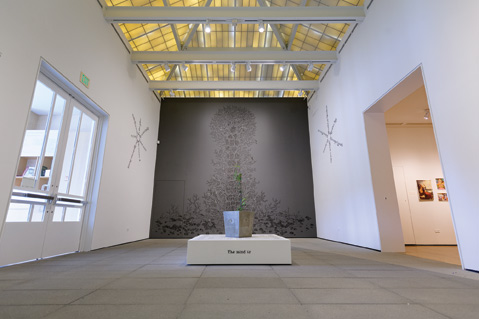Review: The Cave of Treasures at UCSB’s AD&A Museum
Eric Beltz’s Artist-in-Residence Project

“To see is also to touch” reads one of several gothic-style inscriptions currently on the walls of the Adele and Herbert Nachman Courtyard Gallery at UCSB’s Art, Design & Architecture (AD&A) Museum. It’s a good thing — at least as far as Eric Beltz’s The Cave of Treasures goes — that this statement is not literal, as the plant growing out of an elaborate sculptural base in the center of the room is in fact poison oak. Beltz, who finished his MFA degree in art at UCSB in 2004, has been named the AD&A Museum’s 2014-15 artist-in-residence, and although he is known primarily for his small and intricate graphite drawings, he has chosen to take this opportunity to go big and expand his vision to monumental proportions, while still retaining his roots.
Besides the poison oak plant in its black-and-white ornamental vessel, there are two other major works in this installation: a large silver-and-black drawing on paper called “The Mortal Gorgon Medusa” and an even bigger wall drawing in black and gray titled “Medusa’s Scarecrow.” These drawings build on Beltz’s signature style, which marries exquisite traditional draftsmanship and ornamental design to a disquieting iconography of poisonous plants, dangerous mythological figures, and esoteric symbols. Ultimately, the journey through this “cave of treasures” leads to a more holistic view of both nature and culture, in which toxins and scapegoats exist in a healthy synergy with more positively valued life forms.
“The Mortal Gorgon Medusa” establishes several keys to the artist and his project. First off, let it be said that Beltz draws good leaves. The intricate mound that forms the base of this figure and the mandala-like wreath floating just above are both made of delicious and graceful interwoven strands of vegetation. The fact that the specific leaves are those of a variety of poisonous and/or psychogenic plants lends the image an undercurrent of menace, something that will become a recurrent theme in the show. Beltz ties his imagery together by interpolating several large wall texts, each of which is arranged so as to render the reading of them slightly difficult and nonsequential. “Day after day / This superb growth / Which unfolds / Its beauties / Darkness Desire and / Wrathful Wisdom,” says one. A suggestive fragment, it sounds torn from the pages of Macbeth. Medusa, the dark spirit that presides over the entire exhibition, is a figure of great pathos. Once beautiful, she was raped by Poseidon inside a temple to Athena. In retaliation for this defilement of her sanctuary, Athena transformed Medusa into the legend we know today, which is of a woman so profoundly ugly that merely to glimpse her face turns men to stone.
In the show’s largest work, “Medusa’s Scarecrow,” viewers confront a totem pole that towers over the space, stretching some 20 feet up the wall of the gallery. Rather than show the infamous Medusa’s head itself, Beltz has chosen to create an image of her victims as they have become enshrined and then overgrown. The heads of staring men are stacked from floor to ceiling, and they are surrounded by creepy branches that weave in between them before ending in what appear to be either eagle or snake heads. The show’s wall text claims that Medusa “finds refuge and purpose in the natural world,” but this stack of skulls adds up to one very phallic tree and seems to imply as much chaos and death as any kind of natural order. In any case, Beltz has done an outstanding job of transforming this transitional space into something dark and deep as any cave, and that in itself is a treasure.



